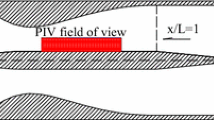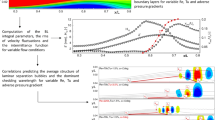Abstract
Laminar separation and transition processes of the boundary layer developing under a strong adverse pressure gradient, typical of Ultra-High-Lift turbine profiles, have been experimentally investigated for a low Reynolds number case. The boundary layer development has been surveyed for different conditions: with steady inflow, with incoming wakes and with the synchronized forcing effects due to both incoming wakes and synthetic jet (zero net mass flow rate jet). In this latter case, the jet Strouhal number has been set equal to half the wake-reduced frequency to synchronize the unsteady forcing effects on the boundary layer. Measurements have been taken by means of a single-sensor hot-wire anemometer. For the steady inflow case, particle image velocimetry has been employed to visualize the large-scale vortical structures shed as a consequence of the Kelvin–Helmholtz instability mechanism. For the unsteady inflow cases, a phase-locked ensemble averaging technique, synchronized with the wake and the synthetic jet frequencies, has been adopted to reconstruct the boundary layer space-time evolution. Results have been represented as color plots, for several time instants of the forcing effect period, in order to provide an overall view of the time-dependent transition and separation processes in terms of ensemble-averaged velocity and unresolved unsteadiness distributions. The phase-locked distributions of the unresolved unsteadiness allowed the identification of the instability mechanisms driving transition as well as the Kelvin–Helmholtz structures that grow within the separated shear layer during the incoming wake interval and the synthetic jet operating period. Incoming wakes and synthetic jet effects in reducing and/or suppressing flow separation are investigated in depth.











Similar content being viewed by others
Abbreviations
- C μ :
-
Jet momentum coefficient \(=\frac{\overline{I}_{j}}{0.5\rho_{0}U_{{\rm ref}}^{2}S}\)
- f :
-
Frequency
- f + :
-
Incoming wake reduced frequency \(=\frac{f_{{\rm wake}}L}{U_{0}}\)
- H 1,2 :
-
Boundary layer shape factor
- \(\overline{I_{j}}\) :
-
Mean jet momentum \(=\frac{1}{T_{j}/2}\rho_{j}S_{j}\int\limits_{0}^{T_{j}/2}u_{j}^{2}(t)\hbox{d}t\)
- L :
-
Plate length
- r :
-
Jet to main flow velocity ratio \(r=\frac{{u}_{{\rm M,j}}}{U_{{\rm ref}}}\)
- Re :
-
Inlet Reynolds number = U 0 L/ν
- S :
-
Main flow passage section
- S j :
-
Synthetic jet passage section
- St :
-
Synthetic jet Strouhal number \(=\frac{f_{j}L}{U_{0}}\)
- t :
-
Time
- T :
-
Wake passage period
- T j :
-
Synthetic jet period
- u :
-
Streamwise velocity
- \(\overline{u}\) :
-
Mean velocity within the separated shear layer
- u j :
-
Velocity induced by synthetic jet actuation
- U 0 :
-
Inlet free-stream velocity
- U e :
-
Local free-stream velocity
- u infl :
-
Streamwise velocity at the inflection point
- u M,j :
-
Maximum jet velocity
- u′rms :
-
Velocity fluctuation root mean square
- U ref :
-
Time-averaged free-stream velocity at x/L = 0.3
- U wake :
-
Incoming wake peripheral velocity
- x :
-
Axial coordinate
- y :
-
Coordinate normal to the wall
- δ w :
-
Vorticity thickness \(=\Updelta u/(\partial u/\partial y)_{{\rm max}}\)
- \(\varphi\) :
-
Flow coefficient \(=\frac{U_{0}}{U_{{\rm wake}}}\)
- λ2 :
-
Imaginary part of the velocity gradient tensor eigenvalue
- ν:
-
Kinematic viscosity
- ρ0 :
-
Main flow density
- ρ j :
-
Synthetic jet density
- ω*:
-
Dimensionless vortex shedding frequency = \(0.25\delta_{w}(2\pi f)/\overline{u}\)
- ′:
-
Fluctuating component
- \( \left\langle {} \right\rangle \) :
-
Ensemble-averaged quantity
References
Alam M, Sandham N (2000) Direct numerical simulation of ‘short’ laminar separation bubbles with turbulent reattachment. J Fluid Mech 410:1–28
Amitay M, Pitt D, Glazer A (2002) Separation control in duct flows. J Aircr 39:616–620
Avdis A, Lardeau S, Leschziner M (2009) Large eddy simulation of separated flow over a two-dimensional hump with and without control by means of a synthetic slot-jet. Flow Turbul Combust 83:343–370
Bloxham M, Reinmann D, Crapo K, Pluim J, Bons JP (2008) Synchronizing separation flow control with unsteady wakes in a low-pressure turbine cascade. ASME J Turbomach 131:021,019.1–021,019.9
Bons JL, Pluim J, Gompertz K, Bloxham M, Clark J (2008) The application of flow control to an aft-loaded low pressure turbine cascade with unsteady wakes. ASME paper GT2008-50864
Burgmann S, Schröder W (2008) Investigation of the vortex induced unsteadiness of a separation bubble via time-resolved and scanning piv measurements. Exp Fluids 45:675–691
Chandrasekhar S (1961) Hydrodynamic and hydromagnetic stability. Oxford University Press, Oxford
Dovgal A, Kozlov V, Michalke A (1994) Laminar boundary layer separation: instability and associated phenomena. Prog Aerosp Sci 30:61–94
Gad-el-Hak M, Bushnell D (1991) Separation control: review. ASME J Fluids Eng 113:5–29
Gilarranz JL, Rediniotis OK (2001) High-power synthetic jet actuators for flow separation control. AIAA paper 2001-0737
Greenblatt D, Paschal KB, Yao CS, Harris J (2006) Experimental investigation of separation control part 2: zero mass-efflux oscillatory blowing. AIAA J 44:2831–2845
Hain R, Kähler C, Radespiel R (2009) Dynamics of laminar separation bubbles at low-reynolds- number aerofoils. J Fluid Mech 630:129–153
Halstead DE, Wisler DC, Okiishi T, Walker GJ, Hodson HP, Shin HW (1997) Boundary layer development in axial compressors and turbines: part 1 of 4- composite picture. ASME J Turbomach 119:114–127
Hodson HP, Howell RJ (2005) The role of transition in high-lift low-pressure turbines for aeroengines. Prog Aerosp Sci 41:419–454
Jeong J, Hussain F (1995) On the identification of a vortex. J Fluid Mech 285:69–94
Jones L, Sandberg R, Sandham N (2008) Direct numerical simulations of forced and unforced separation bubbles on an airfoil at incidence. J Fluid Mech 602:175–207
Kubacki S, Lodefier K, Zarzycki R, Elsner W, Dick E (2009) Further development of a dynamic intermittency model for wake-induced transition. Flow Turbul Combust 83:539–568
Lang M, Rist U, Wagner S (2004) Investigations on controlled transition development in a laminar separation bubble by means of lda and piv. Exp Fluids 36:43–52
Lazaro BJ, Gonzalez E, Vazquez R (2009) Unsteady loss production mechanisms in low Reynolds number, high lift, low pressure turbine profiles. ASME paper GT2007-28142
Lengani D, Simoni D, Ubaldi M, Zunino P, Bertini F (2011) Application of a synthetic jet to control boundary layer separation under ultra-high-lift turbine pressure distribution. Flow Turbul Combust 87:597–616
Lou W, Hourmouziadis J (2000) Separation bubbles under steady and periodic-unsteady main flow conditions. ASME J Turbomach 122:634–643
Marxen O, Lang M, Rist U, Wagner S (2003) A combined experimental/numerical study of unsteady phenomena in a laminar separation bubble. Flow Turbul Combust 71:133–146
Mayle RE (1991) The role of laminar-turbulent transition in gas turbine engines. ASME J Turbomach 113:509–537
McAuliffe B, Yaras M (2010) Transition mechanisms in separation bubbles under low- and elevated-freestream turbulence. ASME J Turbomach 132:011,004–10
Mittal R, Rampunggoon P, Udaykumar HS (2001) Interaction of a synthetic jet with a flat plate boundary layer. AIAA paper 2001-2773
Monkewitz PA, Huerre P (1982) The influence of the velocity ratio on the spatial instability of mixing layers. Phys Fluids 25:1137–1143
Pauley LL, Moin P, Reynolds WC (1990) The structure of two-dimensional separation. J Fluid Mech 220:397–411
Rist U, Maucher U (1994) Direct numerical simulation of 2-d and 3-d instability waves in a laminar separation bubble. In: Proceedings of the AGARD symposium on application of direct and large eddy simulation to transition and turbulence, AGARD-CP-551, Chania, Crete
Satta F, Simoni D, Ubaldi M, Zunino P, Bertini F (2010) Experimental investigation of separation and transition processes on a high-lift low-pressure turbine profile under steady and unsteady inflow at low reynolds number. J Therm Sci 19:26–33
Satta F, Simoni D, Ubaldi M, Zunino P, Bertini F (2010) Synthetic jet design criteria and application for boundary layer separation control. WSEAS Trans Fluid Mech 5:25–34
Satta F, Simoni D, Ubaldi M, Zunino P, Bertini F (2011) Separated-flow transition process on a low-pressure turbine blade under steady and unsteady inflows. In: Proceedings of 9th European turbomachinery conference, Istanbul, Turkey
Schmid PJ, Henningson DS (2001) Stability and transition in shear flows. Springer, New York
Simoni D, Ubaldi M, Zunino P, Lengani D, Bertini F (2012) An experimental investigation of the separated-flow transition under high-lift turbine blade pressure gradients. Flow Turbul Combust 88(1–2):45–62
Sourabh SD, Ramesh O (2009) On the origin of the inflectional instability of a laminar separation bubble. J Fluid Mech 629:263–298
Spalart P, Strelets M (2000) Mechanisms of transition and heat transfer in a separation bubble. J Fluid Mech 403:329–349
Watmuff JH (1999) Evolution of a wave packet into vortex loops in a laminar separation bubble. J Fluid Mech 397:119–169
Yang Z, Voke PR (2001) Large-eddy simulation of boundary-layer separation and transition at a change of surface curvature. J Fluid Mech 439:305–333
Zhang PF, Wang JJ, Feng LH (2008) Review of zero-net-mass-flux jet and its application in separation flow control. Sci China Ser E-Tech Sci 51(9):1315–1344
Zhou J, Adrian RJ, Balachandar S (1996) Autogeneration of nearwall vortical structures in channel flow. Phys Fluids 8:288–290
Acknowledgments
The authors gratefully acknowledge the financial support of the European Commission as part of the research project TATMo, ‘Turbulence and Transition Modeling for Special Turbomachinery Applications’. The authors thank Ph.D. Andrea Ghiglione for the precious support in the design and manufacturing of the facility.
Author information
Authors and Affiliations
Corresponding author
Rights and permissions
About this article
Cite this article
Simoni, D., Ubaldi, M., Zunino, P. et al. Transition mechanisms in laminar separation bubbles with and without incoming wakes and synthetic jet effects. Exp Fluids 53, 173–186 (2012). https://doi.org/10.1007/s00348-012-1281-9
Received:
Revised:
Accepted:
Published:
Issue Date:
DOI: https://doi.org/10.1007/s00348-012-1281-9




